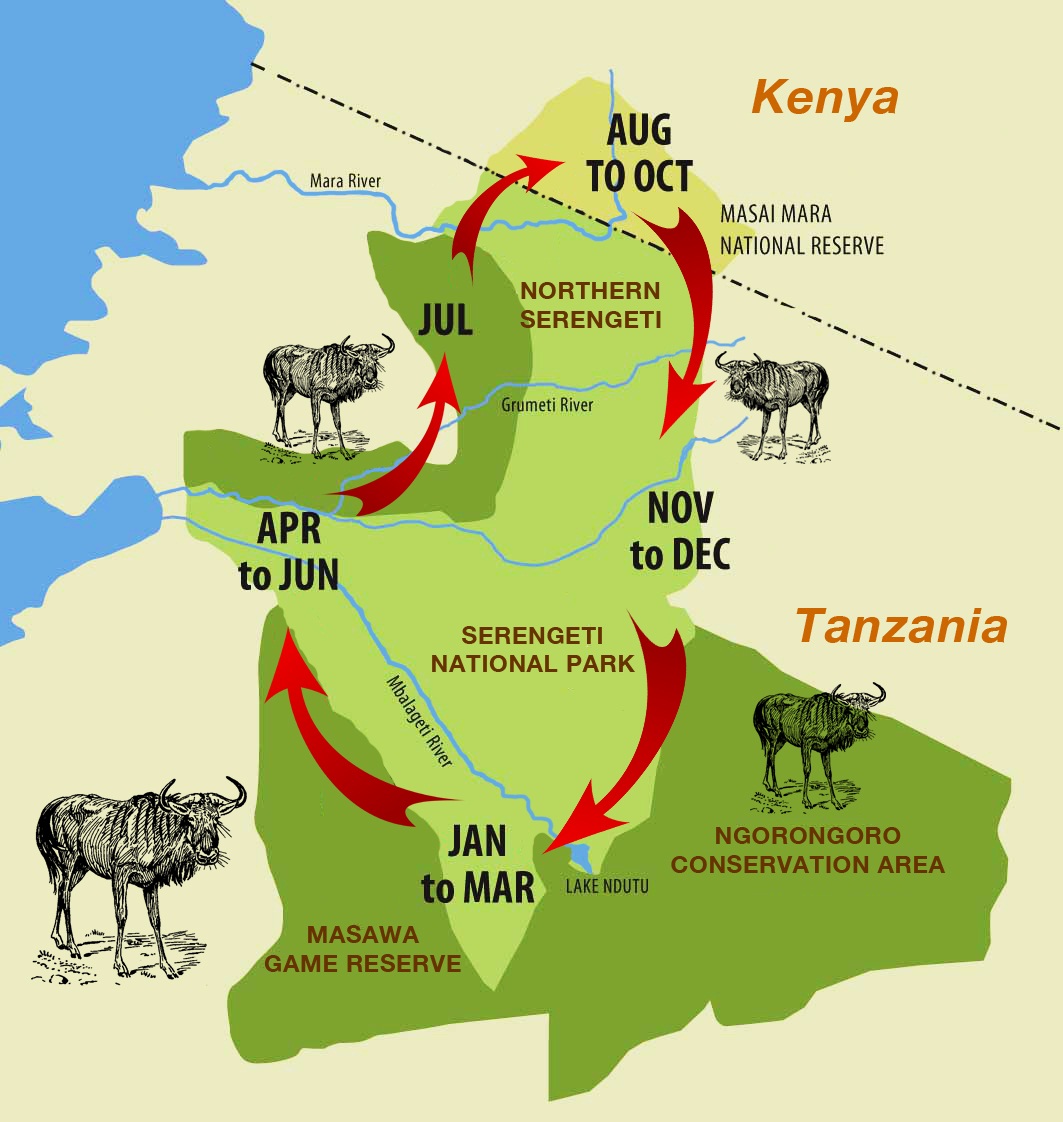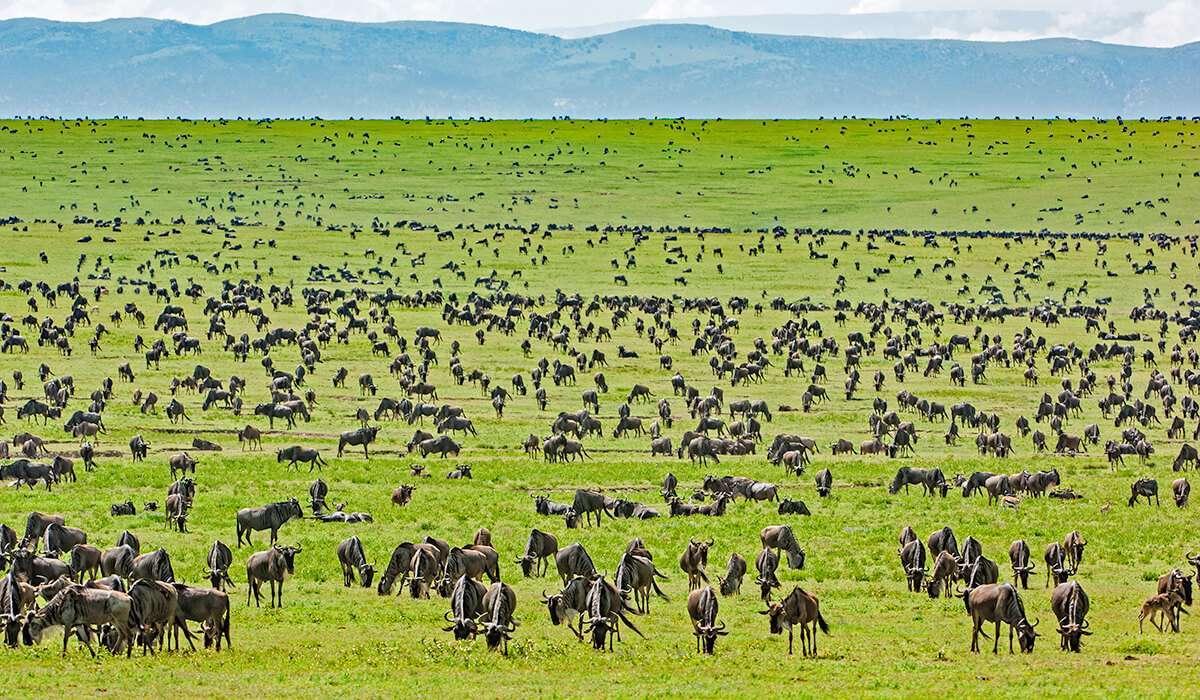All Facts About Wildebeest Migration(Great Migration)
The wildebeest migration is an intricate and dynamic process, showcasing the resilience and adaptability of these animals. The migration is not just a journey for food and water but a vital part of the ecosystem, supporting a diverse range of wildlife and providing a critical tourism boost to Tanzania and Kenya.
Wildebeest Migration Map
The migration map highlights the major routes taken by the herds throughout the year. Key areas include the Serengeti in Tanzania and the Maasai Mara in Kenya.
- Southern Serengeti: January to March
- Central Serengeti: April to June
- Western Corridor: June to July
- Northern Serengeti/Maasai Mara: July to October
- Eastern Serengeti: November to December

Wildebeest Migration in the Serengeti
The Serengeti is the primary stage for the migration. The vast plains provide the grazing grounds needed by the herds, and the Serengeti’s river systems, like the Grumeti and Mara rivers, present challenging obstacles that are essential parts of the migration narrative.
- Southern Serengeti:
- Calving Season: January to March, when around 500,000 calves are born.
- Predators: Lions, hyenas, and cheetahs are abundant due to the vulnerable young.
- Central Serengeti:
- Transition Period: April to June, herds start moving north as the southern plains dry out.
- Rains: The central region sees intermittent rains, providing sporadic grazing opportunities.
- Western Corridor:
- Grumeti River Crossing: June to July, a significant challenge where crocodiles lie in wait.
- Dense Woodland: Provides cover for ambush predators like leopards.
Wildebeest Migration Facts
- Population: The migration includes around 1.5 million wildebeest, 200,000 zebras, and 300,000 gazelles.
- Predation: Predators play a crucial role in maintaining the balance of the ecosystem.
- Birth Rate: Nearly 8,000 calves are born daily during the peak calving season.
- Mortality Rate: High, due to predation, exhaustion, and river crossings.

Wildebeest Migration 2024
While the exact timings may vary slightly due to climate conditions, the general timeline is as follows:
- January-March: Calving in the southern Serengeti.
- April-June: Movement towards the western Serengeti and the Grumeti River.
- July-September: Major river crossings into the Maasai Mara.
- October-December: Returning to the Serengeti.
Wildebeest Migration Distance
- Total Distance: Approximately 1,200 miles (2,000 kilometers).
- Daily Movement: Wildebeest can travel 20-30 miles per day during peak migration periods.
- Challenges: Crossing rivers, predator encounters, and finding sufficient grazing grounds.
Wildebeest Migration: Wonder of the World
- Significance: Regarded as one of the Seven Natural Wonders of Africa.
- Spectacle: The synchronization and sheer scale of the migration make it a unique and awe-inspiring event.
- Tourism: Draws tens of thousands of tourists annually, significantly contributing to local economies.
Wildebeest Migration in Kenya
The Maasai Mara in Kenya is a pivotal part of the migration:
- Mara River Crossings:
- Peak: July to September, dramatic crossings with crocodile attacks.
- Scenic Beauty: Rolling plains and abundant wildlife.
- Predator-Prey Dynamics:
- Lions, Hyenas, and Crocodiles: Major predators in the Maasai Mara.
- Tourist Safaris: Popular for witnessing predator-prey interactions.
Wildebeest Migration Months
Here’s a month-by-month breakdown:
- January-March:
- Location: Southern Serengeti.
- Activity: Calving season, high predator activity.
- April-June:
- Location: Central to Western Serengeti.
- Activity: Herds move towards the western corridor, crossing the Grumeti River.
- July-September:
- Location: Northern Serengeti to Maasai Mara.
- Activity: Major river crossings, grazing in Maasai Mara.
- October-December:
- Location: Returning south to Serengeti.
- Activity: Movement back to calving grounds, grazing along the way.
Conclusion
The wildebeest migration is an intricate and dynamic process, showcasing the resilience and adaptability of these animals. The migration is not just a journey for food and water but a vital part of the ecosystem, supporting a diverse range of wildlife and providing a critical tourism boost to Tanzania and Kenya.
Send us an email at info@nextgensafaris.com Whatssap Inquiry: +4915754442208 for a quick response
A Guide to a Wildebeest Migration Safari
ENTRY REQUIREMENTS FOR A WILDEBEEST MIGRATION SAFARI:
On this A Wildebeest Migration Safari, all visitors must have a valid passport with at least 4 consecutive blanks pages. Any applicable visa and/or relevant documentation are the responsibility of the traveler. For further information on Visa requirements visitors are advised to contact their nearest Kenya or Tanzania Embassy or Consulate.
LANGUAGE ON A WILDEBEEST MIGRATION SAFARI:
English
TIME:
GMT +3
VOLTAGE:
220 Volts/AC50Hz. Sockets are UK style, 3 pin square plugs. Power is from the government in the city/major towns and generator with inverter back up in the Safari Lodges and Camps.
CURRENCY: Foreign currency must be changed at the Bank, Bureau de Change, and Hotel/Safari lodge/Camp/Resort. Major Credit Cards, Master card, Visa, American Express, are usually accepted throughout the country. Where credit cards are accepted, the payment will normally be recorded in US$ regardless of the card’s default currency.
CLOTHING:
Dress is mainly informal and should be comfortable as well as practical. Something warm should be brought along for early morning and evenings. Safari clothes are available from hotels/lodges/camps.
BAGGAGE:
Where possible, travel light. Baggage space on safari is limited to medium suitcase or soft bag per person plus reasonable amount of hand luggage. There is 15 Kilogram per person limit on all flights to the wildlife sanctuaries. Excess luggage must be stored in your arrival hotel.
WATER:
You will find many different of opinion of what is safe and what is not. We recommend for peace of mind, to drink local Bottled Mineral water. It is important to drink plenty of water especially during the hotter months. We would recommend that guests drink at least 2 to 3 liters of water per day to limit the effects of dehydration.
HEALTH;
East Africa is a safe and secure destination; however, it is a good idea to take a few precautions. Kindly consult your GP or local doctor at least 6 weeks before you travel, with regards: Malaria prophylactics. East Africa is a known malaria area and preventive measures are essential. You are advised to take one of the recommended anti-malarial drugs.
Be sure to wear long sleeved shorts and trousers after sunset and spray the exposed parts of your body with a mosquito repellent spray Remember to protect yourself from direct sun rays with sunscreen cream or safari hat.
DIETARY REQUIREMENTS:
For those guests with specific dietary requirement, please ensure we are notified prior to travel
GRATUITIES:
As a guideline and dependent on how happy you are, we would suggest the following: The General Hotel/Lodge/Camp Staff – Approximately U$ 10.00 per person per day Driver Guides – Approximately US$ 15.00 to US$ 20.00 per person per day
PHOTOGRAPHY:
Please be careful when photographing public buildings, airports, bridges, the national flag and people in uniform. Ensure that you have sought permission before photographing local people and their villages. If in doubt, please check with your guide.
Read about
10 Things you Should NOT DO on an African Safari.
What to expect on a safari in Uganda.
Bwindi Impenetrable National Park
How to Choose the Best Tour Operate for Your Safari in Africa
12-Day Gorilla Tracking in Bwindi
Some of our African Safaris
1 Day Jinja Ultimate tour Experience
1 Day White Water Rafting in Jinja
3 Days Bwindi Gorilla Habituation via Rwanda
3 Day Birding Safaris and Photography in Uganda
3 Day Safari to Queen Elizabeth National Park
3 Day fly in Gorilla Trekking Safari from Masai Mara
3 Day Grand Gorilla Trekking Safari
4 Day Chimpanzee and Gorilla Trekking Safari
4 Day Murchison Falls and Jinja tour
Gorilla Trekking Safaris
1 Day Uganda Gorilla Trekking Safari from Kigali Rwanda
3 Days Fly in Gorilla Habituation Safari
3 Days Budget Gorilla Safari in Uganda
3 Days Customizable Rwanda Gorilla Tracking Safari
3 Days Gorilla Trekking Experience and Lake Bunyonyi
3 Days Last Minute Gorilla Trekking & Lake Bunyonyi in Uganda
3 Days Rwanda to Uganda Gorilla Safari
3 Days Uganda Gorilla Safari from Kigali
4 Days Gorilla and Golf Safari in Uganda
4 Days Rwanda Gorilla Adventure
5 Day Gorillas and Game Drive Safari
5 Days Golf and Gorilla Safari in Uganda
5 Days Rwanda Gorillas and Culture Tour
6 Day Uganda Gorilla and Wildlife Tour
6 Days Budget African Safari with Gorilla Trekking
7 Days Gorilla and Chimpanzee Trekking in Uganda
7 Days Uganda Budget Gorillas and Primate Trip
8 Days Gorilla Trekking Vacation to Bwindi National Park
8 Days Uganda Gorilla and Chimpanzee Safari
10 Days Rwanda and Uganda Gorilla Safari
14 Days Uganda Rwanda Study Tour & Gorilla Trekking Trip
BEST AFRICAN DESTINATIONS ITINERARIES
SOUTHERN AFRICA DESTINATION ITINERARIES
Botswana
Mozambique
Namibia
South Africa
Malawi
Zambia
Zimbabwe
EASTERN AFRICA DESTINATION ITINERARIES
Kenya
Rwanda
Tanzania
Uganda
DR. Congo
NORTHERN AFRICA DESTINATION ITINERARIES
South Sudan
INDIAN OCEAN
Madagascar
Zanzibar
Seychelles

